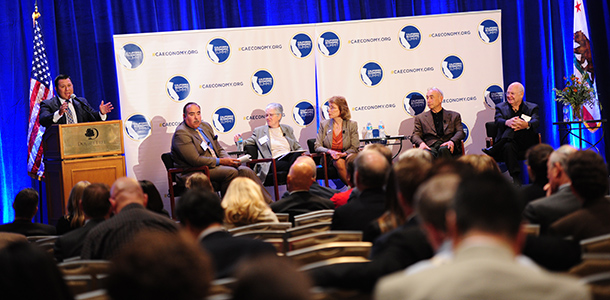
Assemblymember Eduardo Garcia speaking after the California Assembly Committee on Jobs, Economic Development, and the Economy held a hearing ahead of the 2015 California Economic Summit in Ontario. (Photo Credit: Violeta Vaqueiro)
Originally published in the San Bernardino Sun.
The Inland Empire had a chance to show off recently–and we took full advantage of it.
The California Economic Summit came to Ontario and attracted people from across the state who are thinking about and acting on ways we can improve job creation in the Golden State.
Why did the Summit come to Ontario?
There were two reasons:
- The Summit is a regions-based, year-round effort that involves public, civic and elected leaders from across the state. Our region, the Inland Empire, 4.3 million people strong, had never hosted the event.
- We wanted it.
It was a big success. More than 400 people came to Ontario including some important California statewide leaders like Lt. Gov. Gavin Newsom, Secretary of State Alex Padilla, state Treasurer John Chiang and state Controller Betty Yee.
The 2015 Summit developed a number of goals to strengthen the economy and our future by training more workers, building more homes and saving more water. Among them are:
- To support state policies that will orient community colleges to prepare Californians for quality jobs and support regional coordination among colleges and employers.
- To work with the California Legislature in 2016 to promote increased production and find ways to reduce costs for both market-rate and affordable housing
- To use Enhanced Infrastructure Financing Districts, which have long been advanced by the Summit, to fund regional water management that will conserve, capture, and reuse water
In addition, the California Assembly Committee on Jobs, Economic Development, and the Economy (JEDE) held a field hearing immediately prior to the opening of the Summit in Ontario. Hundreds of people, mostly from the Inland Empire, attended to learn about strategies for supporting the entrepreneurial business environment, stabilizing communities, and developing career ladders that provide for wage growth and long-term household security.
“The state is facing an opportunity gap,” said Committee Chairman and Assemblymember Eduardo Garcia. “If left unaddressed, it will only deepen, and undermine the progress we have made.”
Let’s take a minute to think about what the Summit represents. This isn’t something that started in Sacramento. To the contrary, it started in the regions of California, like the Inland Empire, Silicon Valley, the Central Valley, San Francisco, Los Angeles, San Diego and a half-dozen other regions. Local and regional leaders started discussions about what needed to happen in order to make sure that the California economy of the 21st century will excel.
And you know what we found out? Just what we thought we would when California Forward and the California Stewardship Network conceived the idea several years ago: While the regions in California are often different, there are a lot of similarities.
Having a prepared workforce, repairing and replacing our crumbling infrastructure, reducing regulatory paralysis and finding access to capital were some constant themes heard from local leaders across the diverse regions of the state.
The Summit also acknowledged something else. California’s robust economic growth since the end of the recession has not been spread equitably across all regions and communities. There are two Californias–one that does well, mostly around the coastal areas–and another that lags, notably in the inland part of the state.
The California economy will be fully recovered only when all the regions, including ours prosper.
In the meantime, know that hundreds of public, private and civic leaders are working tirelessly to find ways to improve our ability to create the right kind of jobs in California. The work on the issues continues year-round…it never ends.
We invite you to join the movement.
Paul Granillo is President and CEO of the Inland Empire Economic Partnership and is co-chair of the California Economic Summit Steering Committee.

